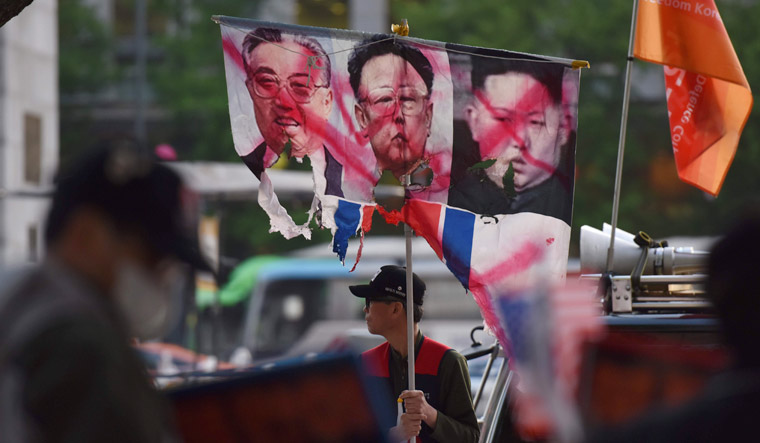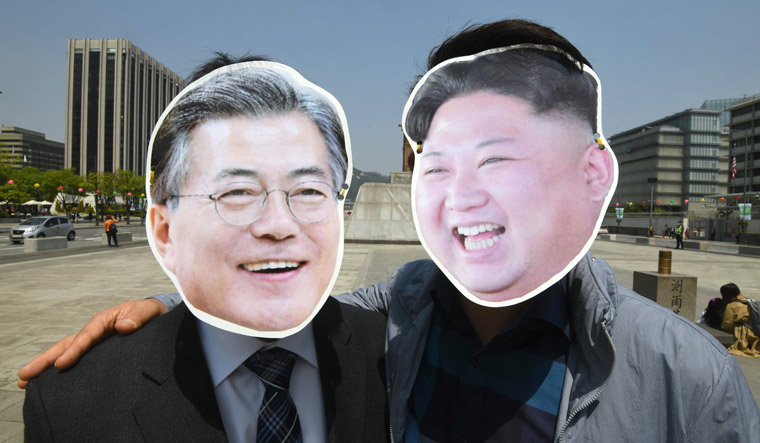After a few days of rains and clouds, Thursday was quite a pleasant day in Seoul. The entire metropolis, along with the rest of South Korea, is in anticipation of the inter-Korean summit, which will be held on April 27. In many parts of Seoul, there are banners and installations offering greetings to the success of the summit. Yet, there have also been stray incidents of protest, by conservative activists, alleging that President Moon Jae-in is going out of his way to please Kim Jong-un, the North Korean despot.
The summit is scheduled to start at 9:30am tomorrow with South Korean President Moon and Kim Jong-un meeting at the Military Demarcation Line in Panmunjom Peace Village in the Demilitarised Zone between the two Koreas.
also read
- Chinese official meets North Korean leader Kim in Pyongyang in highest-level talks in years
- North Korea's Kim drives new-type tank during drills and calls for efforts to prepare for war
- Noticed Son Heung-min's strapped fingers? It's because South Korean stars quarrelled over...
- Samsung chief Lee Jae-yong is acquitted of financial crimes by South Korean court
Kim’s motorcade is expected to drive in from Pyongyang to Panmungak, the main building on the North Korean side of the Joint Security Area of the DMZ, where the armistice agreement ending the Korean war was signed in 1953. He is likely to walk across the military demarcation line into the South Korean territory—the first North Korean head of state to do so—where he will be received by President Moon. The welcome ceremony will include a review of South Korea’s honour guard, another first for a North Korean leader. The honour guard, in particular, has enraged the conservative politicians as they say that South Korean soldiers are being forced by the liberal government to salute a dictator against whom the country is technically still in a state of war.
The welcome ceremony will be followed by initial discussions between the two leaders. In the first half, the least controversial issues are expected to be covered, including the setting up of a joint body to monitor inter-Korean relations on a range of issues including, education, culture and people-to-people ties.
Discussions could also take place on the possibility of concluding a comprehensive peace treaty between the two countries to formally mark the end of the Korean war.
The two sides will break for lunch, after which Moon and Kim will plant a pine tree on the MDL, and will also take a walk around the grounds.
In the afternoon, the talks are likely to focus on the contentious issue of denuclearisation. South Korea hopes to make some progress and recent statements from Kim about his intention to halt nuclear testing by North Korea is seen as a welcome move. The session could also determine the possibility of a summit meeting between Kim and US President Donald Trump. A botched inter-Korean summit is likely to eliminate the chances of the much anticipated summit, which could take place later next month or in June.
The summit will conclude with President Moon hosting a banquet in Kim’s honour.
Officials accompanying Kim Jong-un to the summit include his intelligence chief Kim Yong-chol, army chief Ri Myong-su, defence minister Pak Yong-sik, and foreign Minister Ri Yong-ho. Till now, there is no confirmation about the presence of Kim’s wife, Ri Sol-ju.
Moon will be accompanied by his chief of staff Im Jong-seok, National Security Office chief Chung Eui-yong, National Intelligence Service director Suh Hoon, Unification Minister Cho Myoung-gyon, Defence Minister Song Yong-moo, Foreign Minister Kang Kyung-wha and Gen. Jeong Kyeong-doo, the chief of the Joint Chiefs of Staff.
 A conservative activist displays partially burnt images of late North Korean leaders Kim Il Sung (L), Kim Jong Il (C), and current leader Kim Jong-un, during a protest opposing the inter-Korean summit in Seoul | AFP
A conservative activist displays partially burnt images of late North Korean leaders Kim Il Sung (L), Kim Jong Il (C), and current leader Kim Jong-un, during a protest opposing the inter-Korean summit in Seoul | AFP
The whole world is hoping that the inter-Korean summit will be lucky the third time. The first two summits, despite all the hype, ended up as failures. The first formal inter-Korean summit took place from June 13-15, 2000. South Korean President Kim Dae-jung travelled to Pyongyang to meet Kim Jong-il. The heads of states of the two Koreas were meeting for the first time since the division of the Korean peninsula. Although the two leaders agreed upon a roadmap to reunification through inter-Korean cooperation on humanitarian, economic, political, social and cultural issues, the arrival of George W. Bush as US president complicated matters. Bush named North Korea a member of his ‘axis of evil’ and the North responded with intensifying its nuclear and missile programmes.
Although Kim Dae-jung won the Nobel Peace Prize for his efforts, later it became clear that the summit was held by enticing Pyongyang with hundreds of millions of dollars in bribes and other economic deals. Two members of Kim Dae-jung’s cabinet were indicted for the scandal and it created a huge wave of public opinion about such summits.
The second inter-Korean summit was also held in Pyongyang from October 2-4, 2007. South Korean President Roh Moo-hyun crossed the border to meet Kim Jong-il. The summit came in the backdrop of the six-party peace talks also attended by the United States, China, Japan and Russia. Present President Moon, who was then chief of staff to President Roh, was among the key organisers of the summit. While the summit resulted in a peace agreement, it collapsed soon as North Korea started preparing for the leadership of Kim jong-un because of his father Kim Jong-il’s frail health, and also because of a controversy that erupted in South Korea about President’s Roh’s offer during the summit to redraw the Northern Limit Line, the sea border between North and South Korea in the Yellow Sea. The South Korean conservatives alleged a sell out and blocked all further concessions.
President Moon will have to work really hard to make the summit a success. He will have to offer Kim a palatable deal. At the same time, he will also have to convince the conservatives in his country and also the youth about the significance of the deal he cuts with Kim. Young South Koreans are not so keen on giving any concessions to North Korea. Unemployment rates are very high among young people, and they are worried that reconciliation with the North and possible reunification in the future will make the economic situation worse for them.
Still, tomorrow’s summit offers a great chance for peace in the Korean Peninsula, and to end forever one of the festering wounds of the Cold War that has been lingering for almost a quarter century after the disintegration of the USSR.


